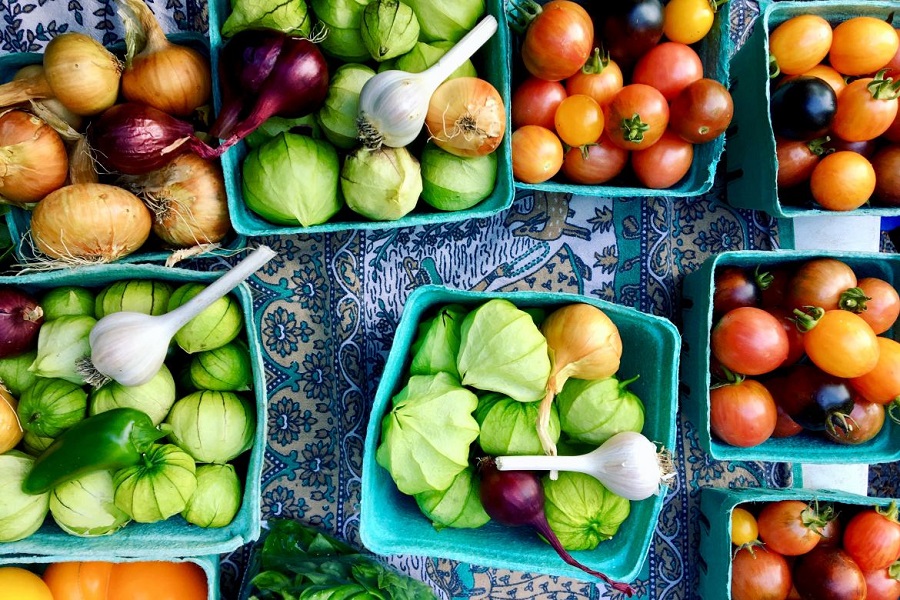Is budgeting for a healthy, organic diet an obstacle to your health and wellness goals? Here are some of our favorite ways to make healthy eating affordable, practical and enjoyable!
Shop local
As summer approaches, we are entering farmer’s market season and this is a great opportunity to find high quality and organic produce at budget-friendly prices. Markets are also a good opportunity to connect with the people in your community that are growing the foods you eat. In building this connection, you can ask them directly about how they grow their crops and what kind of pesticides they use (organic versus conventional). Another benefit of farmers markets is that the produce is often fresh picked from the morning – meaning that your tomatoes were able to ripen on the vine instead of in a truck, warehouse, or at the grocery store.
Shop seasonally
When you cannot get to a farmer’s market, you can still shop within season at your local grocery stores and co-ops to plan for more budget-friendly meals. Seasonal fruits and vegetables are generally more abundant, which equates to a lower price (and peak flavors, win-win!). If you have something special that you need to make but the produce is out of season, look in the freezer section to save a few dollars but also be mindful that some frozen fruits and vegetables have sugars, salts, or sauces added – check your labels. It’s also possible to buy in bulk when seasonal fruits and vegetables are cheaper and freeze it at home for later. Utilizing the Dirty Dozen and Clean Fifteen lists, which are updated annually by the Environmental Working Group, can also help by prioritizing which items should absolutely be organic and which ones are okay to opt for conventionally grown sources.
Shop sales
Meal planning can take some time and effort, but it can pay off big time when sticking to a grocery budget. If you can set aside time every week to review your local sales and ads in the newspaper or online before you head to the store, it will help guide your meals for that week around what is on sale. Creating a shopping list and sticking to it while you are at the store will ensure that you comply with your budget as well, and thorough planning will reduce spontaneous trips to the grocery store mid-week when you may be tempted to purchase unnecessary things. Planning your meals around sales may also force you to get creative and try something new! Cooking these meals in triple or quadruple batches will also allow you to freeze extra leftovers to have meals on hand, and use some for lunch the next day or two – decreasing temptations of going out to eat.
Shop whole foods
Stock up on pantry staples (especially when on sale) and utilize the bulk bins. By opting for whole grains and beans in the bulk bins, you can save money on packaging and marketing from pre-packaged options. If tolerated, beans can be a great source of protein, fiber and other nutrients plus they can help fill you up without blowing your budget on more expensive cuts of meat.
Do your kids love granola and trail mix but you don’t want to pay $6 for a bag that will last 2 days at most? Try getting bulk oats, nuts, dried fruits and seeds to make your own granola for much less. Stick to the perimeter of the store to avoid the temptations and expense of processed and packaged foods – not only will this help to keep your budget in check but these foods are often devoid of nutrients and loaded with artificial additives and preservatives that don’t benefit your health. Want to go the extra step? Store your cooked and bulk food in reusable glass and stainless steel containers to cut down on plastics as well.
Don’t forget the “scraps”
Often when chopping and peeling vegetables or cooking meats, the leftover bits and pieces are thrown away. However, you can utilize those organic chicken bones, beef bones, celery tops, carrot ends and so on to make a delicious broth that can then be the base for your next soup or stew. This significantly saves on buying prepared boxed broths and helps you skip the added salt and preservatives when cooking. You can store your broth in the fridge if using soon or label, date, and freeze to keep your freezer organized. To help reduce waste as well, try to use the more perishable items of your shopping list earlier in the week (such as fish, raw meats, berries and salad greens) and plan to use the heartier ingredients (such as legumes, whole grains, and root vegetables) later in the week.
We hope this helps keep your budget on track and healthy eating more affordable!
Looking for more nutritional advice or guidance? Set up an appointment with our functional dietitian, Rachel Wood!


